Did you know that between 2013 and 2014, 22,200 fires were reported in properties other than dwellings? Although this number has steadily declined over the years, it still goes to show that fire is a risk that workplaces need to attend to on top of their other duties.
This is especially important for retail stores, as the fire fatality rate for people age 80 or higher is four times higher than the average of all ages. This means that commercial owners have the responsibility of mitigating the risk of fire–even if they believe they would be able to outrun it or put it out in time.
With this in mind, read on to learn all about fire risk assessment and why fire awareness is crucial for your employees to begin training today!
What is an Office Fire Risk Assessment?
You can consider a fire and explosion risk assessment as an “audit” of your workplace. The aim is to limit hazards in your workplace so that there’s a lower fire risk overall.
After a fire risk assessment is completed, if necessary, a responsible party will also be given a list of ways to reduce fire risk in the building. The goal is not to put more burdens on your employees–it’s to keep everyone safe from harm.
Here are some of the items that a fire risk assessment covers:
- Detecting emergency routes and exits
- Creating emergency plans
- Making sure there are fire detection systems in place
- Ensuring that fire warning systems are operable
- Making sure that fire fighting equipment is operable
- Removing dangerous substances
- Creating a fire evacuation plan
- Assessing the needs of vulnerable people such as the elderly
- Providing fire safety training for staff
As you can see, fire assessments are detailed and thorough. They cover everything you need to do in order to mitigate your work’s risk of a fire as well as how to continue to reduce your risks.
Fire investigation training is also important in order to deal with incidents after they’ve occurred.
Evaluating a Risk: Detecting a Fire
Making sure that your fire equipment is working and updated is one of the most important aspects of mitigating fire risk. Not only can this equipment save lives, but it can also mitigate the damage done to your property. Fire marshals in the workplace as well as all other employees need to be aware of this equipment.
You’ll want to regularly test your fire detection equipment to see that it’s heard by everyone. If there are employees that are hard of hearing, this equipment also needs bright lights.
If it’s electrically powered, the equipment needs to have a backup supply. If it’s battery-operated, it’s important that the batteries are changed regularly.
Lastly, your fire detection equipment needs to be updated. The equipment needs to be able to alert you and your employees with ample time for you to escape.
Evaluating Risk: Escape Routes
Escape routes are a large part of evaluating fire risk. The reason for this is because when a fire gets out of control, escape routes are the only option for people to remain safe, especially those that are more at risk such as the elderly.
Here are some ways the escape routes at your workplace are assessed:
Adequate for the Number of People
Your escape route needs to be adequate for the number of people in your building. It also needs to be able to accommodate anyone with disabilities as well as the elderly.
Direct
Your escape routes need to have a direct route to safety. This means the routes need to be as short as reasonably possible. The faster people are able to escape the building, the better.
Clear
The escape routes need to be kept clear at all times. Since they’re used infrequently, some workplaces make the mistake of using them as extra storage areas, blocking them off with materials or equipment, or failing to identify them clearly. Escape routes need to be easily available at all times.
Lighting
Remember that your escape routes need to remain lit in order for people to use them safely. Make sure that they have backup power.
Signs
Last but not least, there needs to be clear signs for an escape route. Remember that in a moment of panic, your first instinct is to run to the nearest door. This is why escape signs need to be bold and easy to see so that everyone uses the correct exit to quick safety.
Common Causes of Fire in the Workplace
Now that you know what a fire risk assessment is and why it’s so necessary, what are some of the common causes identified? Here are a few things to keep in mind:
Faulty Electrical Equipment
This is one of the top causes of fires in the workplace. One of the reasons is that this can happen in buildings and industries of all types–everyone needs access to electricity. Workplaces often try to cut costs by overloading plugs with appliances and computer equipment.
Loose wires and faulty connections can also cause fires, especially when wires are unorganized and hidden behind desks and other obstacles. Not only cause a fire, but people won’t be able to recognize something is wrong until it’s too late.
Flammable Materials
Fire risk assessments are important because professionals can quickly identify improperly stored flammable materials in your workplace. Workshops are particularly prone to this risk, as sparks from tools and industrial equipment can ignite flammable materials that are nearby.
Your workplace may need to store large quantities of flammable materials. With this in mind, risk assessments can help workplaces figure out strategies to store and handle these materials in a safe way.
Lack of Equipment
Fire detection and warning systems can easily be ignored, especially if emergency situations don’t happen often. However, they’re necessary in order to have a safe workplace because they can sound an alarm before the fire gets out of control.
Along with fire detection systems, employees need reliable ways to put out small fires before they become a danger to life. For this reason, fire extinguishers need to be a part of every workplace. Even more importantly, employees need to know where to find these fire extinguishers as well as how to use them.
Human Error
Even if all of your fire detection equipment and storage solutions are up-to-date, human error can still cause fires no matter how prepared you are. From not attending to cooking equipment to not reporting machinery issues, all of these minor errors can lead to huge consequences.
This is why fire risk training is so important. Employees will learn about common things to look for in order to have a safer workplace. They’ll also be made aware of exit routes in the case of an emergency, how to use fire extinguishers and where to find them, and more.
With a fully trained and educated workforce, you can combat accidents.
How Often Should You Have Fire Risk Training?
Fire risk assessment training is one of the most important scheduled tasks you can perform in order to mitigate the danger of fire in your workplace. The Regulatory Reform Order (RRO) of 2005 states that the owner, manager, or occupier of a space needs to regularly perform fire risk assessments.
A good rule of thumb is to have a fire risk assessment every 12 months with you and the rest of your employees. This is because you’ll be able to refresh everyone’s knowledge of fire safety as well as what to do if there is a fire.
Everyone will be able to identify fire risks before they become a real danger. With the whole team helping, you won’t put yourself in dangerous situations. Make sure to keep a full, written record of each assessment so that you won’t make the same mistakes twice.
Schedule Your Fire Risk Assessment Today for a Safe Workplace
Fire risk assessments are smart ways to get your entire workforce prepared for a fire. Imagine what would happen if none of your employees knew about how to handle a fire once they discovered one. Some would naturally run to safety, but there may not be any reliable escape routes if the fire is already growing out of control.
Others would try to jump in to help, but you may not even have fire extinguishers at the ready. Even worse, they may not even know how to use them! In this nightmare scenario, thousands of pounds would be eaten up by a raging fire. In the best case scenario, no one is seriously injured.
This shouldn’t happen to your workplace. Fire risk assessments will ensure that everyone is prepared when an accident occurs.
If you’re ready for a fire risk assessment and training, contact us today to get started!





0 Comments